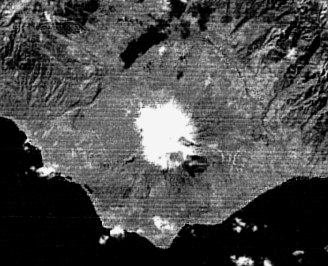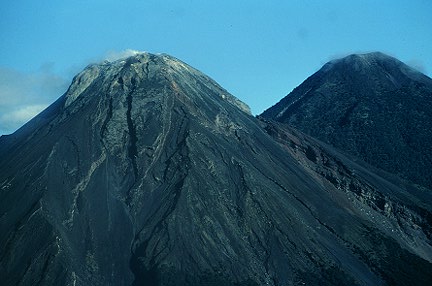
Komagatake
A volcano is a coned shape place on land were lava flows out. That would the definition of a volcano to most people, but there is more that happens then just what we see. A volcano does not necessarily have to be above water. The Hawaiian Islands were formed from an underwater volcano.
A volcano is formed when one plate (techonic plate) slides under another. When this happens the magma (lava that has not yet reached the surface) that is deep inside the volcano is disturbed the plate that is plunging under the other one. The magma then reaches the surface and is called lava. The lava then flows out of the volcano and down the mountainside.
There are 23
tectonic plates that seperate the world into a puzzle. These plates move
approximately 2 inches a year the. But when the plates have a quick movement
that is when disaster strikes. This can also cause an earthquake. The plates
not move much, as you can tell but the plates do move and every once in
a while a volcano erupts. Volcano's erupt all over the world. One of the
world's best known volcano's is Mount St. Hellens. Mount St. Helens
is located on the Ring of Fire which is were many volcanos and earthquakes
happen

Komagatake
Komagatake a
mountain in Hokkaido Japan erupted on November 9th of 2000. The volcano
is 1,133 m high. Its coordinates is 42.07 N and 140.58 E.
This is a summarized version of
the events leading up to the eruption.
The first eruption happened on September 28, 2000. The eruption shot out volcanic ash on the mountainside town. There were no injuries reported. The second eruption on October 31, 2000 also shot out volcanic ash that lay over the city of Shikabe. There were five volcanic tremors report by the Sapporo District Meteorological Observatory. The main eruption happened on November 8, 2000. There was a 10 minute volcanic tremor that followed the eruption.
Fuego
Fuego, Guatemala is the site of the next volcano. Fuego has erupted 60 times since 1524. This makes it central America's most active volcano. It last erupted September 22, 2000. Fuego is 12,342 ft high. Its coordinates is 14.5 N and 90.9 W
These are the
events leading up to the main eruption. On July 19, 1999 Fuego let out
small ash deposits. This was noted as a hot spot on satellite imagery.
On September 5, 2000 Fuego let out a 2,600 foot stream of ash.
A warning was issued for the area.
On September 21, 2000 Fuego let out more ash and authorities are thinking
of an evacuation of the area.

Hazards of Volcanos
The hazards of volcanos are ash, lava, and volcanic tremors. The problem with ash as that it is blinding if you are outside and trying drive or walk. Other problems are that it takes the oxygen out of the air and makes it hard to breathe. Lava has many problems it is hot and will melt almost any thing in its way. Volcanic tremors happen after some eruptions. It is like a small earthquake.
Why Does a Volcano Erupt
The world is separated into 23 tectonic plates. These plates move a little each year. The real damage is done when one of the plates dives under other. If there is a volcano around the plate may hit the volcanos magma chamber. When this happens the magma is disturbed and it starts to flow up and out of the volcano.
The Signs That a Eruption is Near
Some of the signs that an eruption is near are is bulging and gasses. If there are gasses coming from the volcano's peak this is showing that the gasses are building up ready to burst. The bulging is when one or all sides are popping out. This means that the magma is building up inside and ready to burst. These are only a few of the signs of eruption.
![]()
Hazards
of volcanoes
Why does
a volcano erupt
Signs
of eruption
![]()